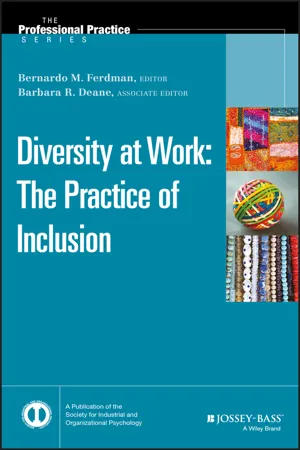
- English
- ePUB (mobile friendly)
- Available on iOS & Android
About this book
Diversity at Work: The Practice of Inclusion
How can organizations, their leaders, and their people benefit from diversity? The answer, according to this cutting-edge book, is the practice of inclusion. Diversity at Work: The Practice of Inclusion (a volume in SIOP's Professional Practice Series) presents detailed solutions for the challenge of inclusion—how to fully connect with, engage, and empower people across all types of differences. Its editors and chapter authors—all topic experts ranging from internal and external change agents to academics—effectively translate theories and research on diversity into the applied practice of inclusion. Readers will learn about the critical issues involved in framing, designing, and implementing inclusion initiatives in organizations and supporting individuals to develop competencies for inclusion. The authors' diverse voices combine to provide an innovative and expansive model of the practice of inclusion and to address its key aspects at the individual, group, and organizational levels. The book, designed to be a hands-on resource, provides case studies and illustrations to show how diversity and inclusion operate in a variety of settings, effectively highlighting the practices needed to benefit from diversity. This comprehensive handbook:
- Explains how to conceptualize, operationalize, and implement inclusion in organizations.
- Connects inclusion to multiple dimensions of diversity (including gender, race, ethnicity, nationality, social class, religion, profession, and many others) in integrative ways, incorporating specific and relevant examples.
- Includes models, illustrations, and cases showing how to apply the principles and practices of inclusion.
- Addresses international and multicultural perspectives throughout, including many examples.
- Provides practitioners with key perspectives and tools for thinking about and fostering inclusion in a variety of organizational contexts.
- Provides HR professionals, industrial-organizational psychologists, D&I practitioners, and those in related fields—as well as anyone interested in enhancing the workplace—with a one-stop resource on the latest knowledge regarding diversity and the practice of inclusion in organizations.
This vital resource offers a clear understanding of and a way to navigate the challenges of creating and sustaining inclusion initiatives that truly work.
Frequently asked questions
- Essential is ideal for learners and professionals who enjoy exploring a wide range of subjects. Access the Essential Library with 800,000+ trusted titles and best-sellers across business, personal growth, and the humanities. Includes unlimited reading time and Standard Read Aloud voice.
- Complete: Perfect for advanced learners and researchers needing full, unrestricted access. Unlock 1.4M+ books across hundreds of subjects, including academic and specialized titles. The Complete Plan also includes advanced features like Premium Read Aloud and Research Assistant.
Please note we cannot support devices running on iOS 13 and Android 7 or earlier. Learn more about using the app.
Information
Part One
Frameworks for Understanding Inclusion
CHAPTER ONE
The Practice of Inclusion in Diverse Organizations: Toward a Systemic and Inclusive Framework
Inclusion as the Key to Diversity's Benefits
Diversity at Work
Table of contents
- Cover
- Table of Contents
- Praise for Diversity at Work: The Practice of Inclusion
- The Professional Practice Series
- Series
- The Professional Practice Series
- Title
- Copyright
- List of Tables, Figures, and Exhibits
- Foreword
- Preface
- The Editors
- The Authors
- Part One: Frameworks for Understanding Inclusion
- Part Two: Individual and Interpersonal Perspectives and Practices
- Part Three: Organizational and Societal Perspectives and Practices
- Part Four: Key Application Issues and Domains
- Part Five: Moving Forward
- End User License Agreement